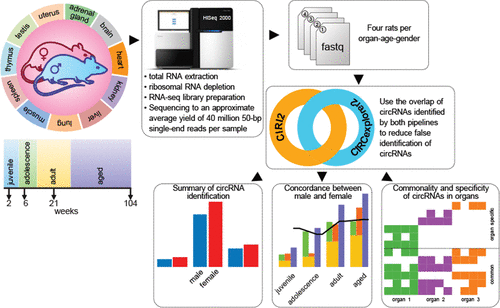当前位置:
X-MOL 学术
›
Chem. Res. Toxicol.
›
论文详情
Our official English website, www.x-mol.net, welcomes your
feedback! (Note: you will need to create a separate account there.)
Landscape of circRNAs Across 11 Organs and 4 Ages in Fischer 344 Rats
Chemical Research in Toxicology ( IF 3.7 ) Pub Date : 2020-07-21 , DOI: 10.1021/acs.chemrestox.0c00144 Binsheng Gong 1 , Joshua Xu 1 , Weida Tong 1
Chemical Research in Toxicology ( IF 3.7 ) Pub Date : 2020-07-21 , DOI: 10.1021/acs.chemrestox.0c00144 Binsheng Gong 1 , Joshua Xu 1 , Weida Tong 1
Affiliation

|
Circular RNAs (circRNAs) are a class of endogenous noncoding RNAs with a covalently closed loop. Aside from their recognized regulatory functions (e.g., sponging microRNAs to reduce their activity, and altering parental gene transcription by competing with the canonical splicing of pre-mRNA), expression of circRNAs is abundant, diverse, and conservative across species, rendering them as potential biomarker candidates. Consequently, the landscape of circRNAs has been studied for several species. Although the rat is one of the most important animal models for drug safety and toxicological research, few attempts have been made to understand the landscape of rat circRNAs. One noticeable challenge in analyzing circRNAs with next-generation sequencing (NGS) data is to find ways to use rapidly advancing bioinformatics approaches to improve accuracy while also reducing the number of resulting false positives that occur in circRNA identification with these new methods. Here, we applied two of the most advanced circRNA bioinformatics pipelines to provide a landscape of circRNAs in rats by analyzing an RNA-seq data set for 11 organs (adrenal gland, brain, heart, kidney, liver, lung, muscle, spleen, thymus, and testis or uterus) from Fischer 344 rats of both sexes in four age groups (juvenile, adolescence, adult, and aged). The circRNAs displayed organ-specific patterns and sex differences in most organs. Lowest numbers of circRNAs were seen in the liver and muscle, while highest numbers of circRNAs occurred in the brain, which correlated to gene expression patterns seen across those organs. Concordance of circRNAs between males and females was approximately 50% in nonsex organs, implying that some caution needs to be exercised when selecting specific circRNAs as biomarkers for both sexes. The number of common circRNAs between sexes increased with age for most organs except heart, spleen, and thymus. A dramatic drop in the number of circRNAs in kidney, thymus, and testis was observed in aged rats, suggesting that the regulatory function of circRNAs is age dependent. From the 1595 circRNAs identified with high confidence, only 6 appeared in all 9 of the nonsex organs in both sexes and four age groups. Forty-one and 48 circRNAs were identified in more than 5 nonsex organs in males and females, respectively, while close to 280 circRNAs were found in an organ for more than 2 age groups in both sexes. This study offers an overview of rat circRNAs, which contributes to the effort of identifying circRNAs as potential biomarkers for safety and risk assessment.
中文翻译:

Fischer 344 大鼠 11 个器官和 4 个年龄的 circRNA 景观
环状RNA(circRNA)是一类具有共价闭合环的内源性非编码RNA。除了它们公认的调节功能(例如,海绵状 microRNAs 以降低其活性,并通过与 pre-mRNA 的规范剪接竞争来改变亲本基因转录),circRNAs 的表达在物种间是丰富的、多样的和保守的,使它们成为潜在的生物标志物候选者。因此,已经针对多个物种研究了 circRNA 的景观。尽管大鼠是药物安全性和毒理学研究最重要的动物模型之一,但很少有人试图了解大鼠 circRNA 的情况。使用新一代测序 (NGS) 数据分析 circRNA 的一个显着挑战是找到方法使用快速发展的生物信息学方法来提高准确性,同时减少使用这些新方法识别 circRNA 中产生的假阳性数量。在这里,我们应用了两个最先进的 circRNA 生物信息学管道,通过分析 11 个器官(肾上腺、脑、心脏、肾脏、肝脏、肺、肌肉、脾脏、胸腺)的 RNA-seq 数据集来提供大鼠的 circRNA 景观。和睾丸或子宫)来自四个年龄组(少年、青春期、成年和老年)的 Fischer 344 只雌雄同体大鼠。circRNA 在大多数器官中显示出器官特异性模式和性别差异。肝脏和肌肉中的 circRNA 数量最少,而大脑中的 circRNA 数量最多,这与在这些器官中看到的基因表达模式相关。在非性器官中,男性和女性之间 circRNA 的一致性约为 50%,这意味着在选择特定的 circRNA 作为两性生物标志物时需要谨慎行事。对于除心脏、脾脏和胸腺外的大多数器官,两性之间常见的 circRNA 数量随着年龄的增长而增加。在老年大鼠中观察到肾脏、胸腺和睾丸中 circRNA 的数量急剧下降,表明 circRNA 的调节功能具有年龄依赖性。在以高置信度鉴定的 1595 个 circRNA 中,只有 6 个出现在所有 9 个非性器官中,男女和四个年龄组。分别在男性和女性的 5 个以上非性器官中鉴定出 41 个和 48 个 circRNA,而在一个器官中发现了近 280 个 circRNA,超过 2 个年龄组的男女。本研究概述了大鼠 circRNA,这有助于将 circRNA 识别为潜在的安全和风险评估生物标志物。
更新日期:2020-07-21
中文翻译:

Fischer 344 大鼠 11 个器官和 4 个年龄的 circRNA 景观
环状RNA(circRNA)是一类具有共价闭合环的内源性非编码RNA。除了它们公认的调节功能(例如,海绵状 microRNAs 以降低其活性,并通过与 pre-mRNA 的规范剪接竞争来改变亲本基因转录),circRNAs 的表达在物种间是丰富的、多样的和保守的,使它们成为潜在的生物标志物候选者。因此,已经针对多个物种研究了 circRNA 的景观。尽管大鼠是药物安全性和毒理学研究最重要的动物模型之一,但很少有人试图了解大鼠 circRNA 的情况。使用新一代测序 (NGS) 数据分析 circRNA 的一个显着挑战是找到方法使用快速发展的生物信息学方法来提高准确性,同时减少使用这些新方法识别 circRNA 中产生的假阳性数量。在这里,我们应用了两个最先进的 circRNA 生物信息学管道,通过分析 11 个器官(肾上腺、脑、心脏、肾脏、肝脏、肺、肌肉、脾脏、胸腺)的 RNA-seq 数据集来提供大鼠的 circRNA 景观。和睾丸或子宫)来自四个年龄组(少年、青春期、成年和老年)的 Fischer 344 只雌雄同体大鼠。circRNA 在大多数器官中显示出器官特异性模式和性别差异。肝脏和肌肉中的 circRNA 数量最少,而大脑中的 circRNA 数量最多,这与在这些器官中看到的基因表达模式相关。在非性器官中,男性和女性之间 circRNA 的一致性约为 50%,这意味着在选择特定的 circRNA 作为两性生物标志物时需要谨慎行事。对于除心脏、脾脏和胸腺外的大多数器官,两性之间常见的 circRNA 数量随着年龄的增长而增加。在老年大鼠中观察到肾脏、胸腺和睾丸中 circRNA 的数量急剧下降,表明 circRNA 的调节功能具有年龄依赖性。在以高置信度鉴定的 1595 个 circRNA 中,只有 6 个出现在所有 9 个非性器官中,男女和四个年龄组。分别在男性和女性的 5 个以上非性器官中鉴定出 41 个和 48 个 circRNA,而在一个器官中发现了近 280 个 circRNA,超过 2 个年龄组的男女。本研究概述了大鼠 circRNA,这有助于将 circRNA 识别为潜在的安全和风险评估生物标志物。











































 京公网安备 11010802027423号
京公网安备 11010802027423号